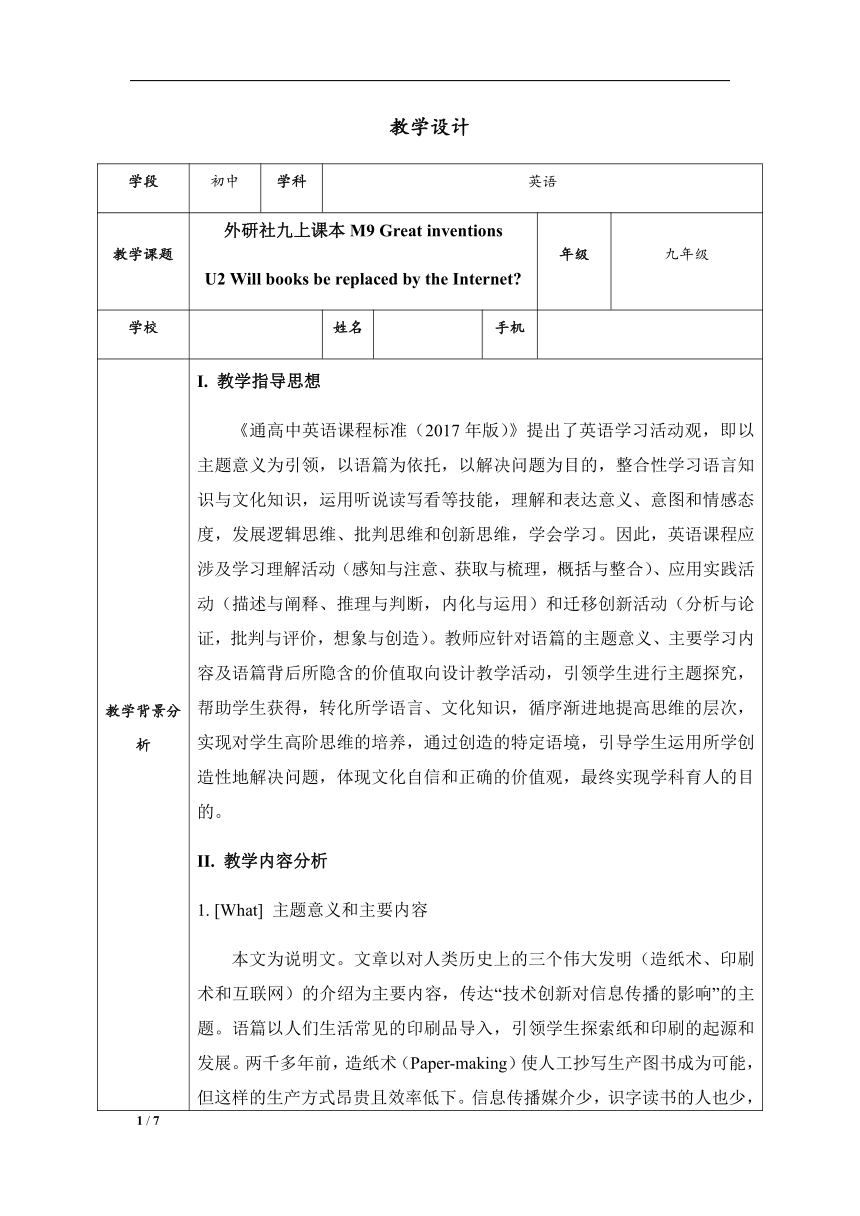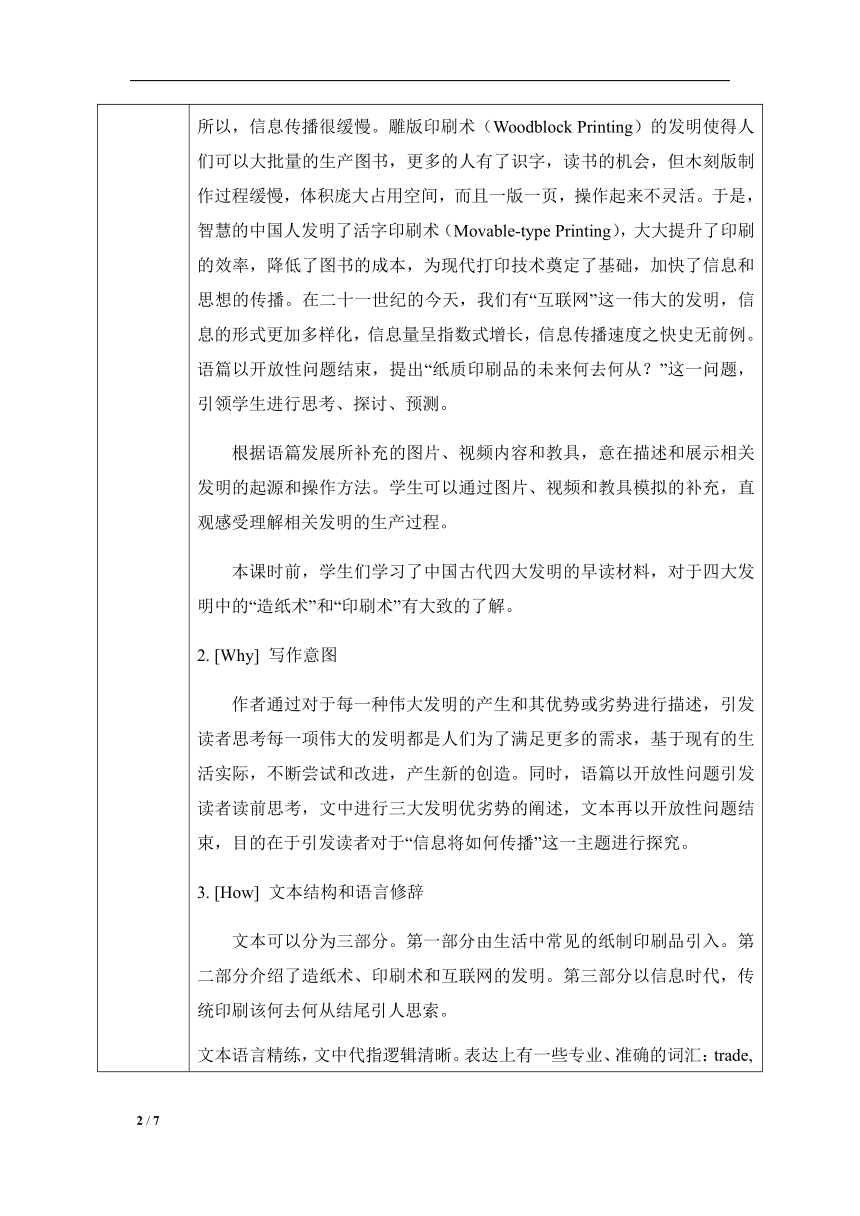外研版九年级上册 Module 9 unit2 Will books be replaced by the Internet?.教案
文档属性
| 名称 | 外研版九年级上册 Module 9 unit2 Will books be replaced by the Internet?.教案 |  | |
| 格式 | docx | ||
| 文件大小 | 30.5KB | ||
| 资源类型 | 教案 | ||
| 版本资源 | 外研版 | ||
| 科目 | 英语 | ||
| 更新时间 | 2020-09-30 16:33:57 | ||
图片预览



文档简介
1205230011722100教学设计
学段
初中
学科
英语
教学课题
外研社九上课本M9 Great inventions
U2 Will books be replaced by the Internet?
年级
九年级
学校
姓名
手机
教学背景分析
I. 教学指导思想
《通高中英语课程标准(2017年版)》提出了英语学习活动观,即以主题意义为引领,以语篇为依托,以解决问题为目的,整合性学习语言知识与文化知识,运用听说读写看等技能,理解和表达意义、意图和情感态度,发展逻辑思维、批判思维和创新思维,学会学习。因此,英语课程应涉及学习理解活动(感知与注意、获取与梳理,概括与整合)、应用实践活动(描述与阐释、推理与判断,内化与运用)和迁移创新活动(分析与论证,批判与评价,想象与创造)。教师应针对语篇的主题意义、主要学习内容及语篇背后所隐含的价值取向设计教学活动,引领学生进行主题探究,帮助学生获得,转化所学语言、文化知识,循序渐进地提高思维的层次,实现对学生高阶思维的培养,通过创造的特定语境,引导学生运用所学创造性地解决问题,体现文化自信和正确的价值观,最终实现学科育人的目的。
II. 教学内容分析
1. [What] 主题意义和主要内容
本文为说明文。文章以对人类历史上的三个伟大发明(造纸术、印刷术和互联网)的介绍为主要内容,传达“技术创新对信息传播的影响”的主题。语篇以人们生活常见的印刷品导入,引领学生探索纸和印刷的起源和发展。两千多年前,造纸术(Paper-making)使人工抄写生产图书成为可能,但这样的生产方式昂贵且效率低下。信息传播媒介少,识字读书的人也少,所以,信息传播很缓慢。雕版印刷术(Woodblock Printing)的发明使得人们可以大批量的生产图书,更多的人有了识字,读书的机会,但木刻版制作过程缓慢,体积庞大占用空间,而且一版一页,操作起来不灵活。于是,智慧的中国人发明了活字印刷术(Movable-type Printing),大大提升了印刷的效率,降低了图书的成本,为现代打印技术奠定了基础,加快了信息和思想的传播。在二十一世纪的今天,我们有“互联网”这一伟大的发明,信息的形式更加多样化,信息量呈指数式增长,信息传播速度之快史无前例。语篇以开放性问题结束,提出“纸质印刷品的未来何去何从?”这一问题,引领学生进行思考、探讨、预测。
根据语篇发展所补充的图片、视频内容和教具,意在描述和展示相关发明的起源和操作方法。学生可以通过图片、视频和教具模拟的补充,直观感受理解相关发明的生产过程。
本课时前,学生们学习了中国古代四大发明的早读材料,对于四大发明中的“造纸术”和“印刷术”有大致的了解。
2. [Why] 写作意图
作者通过对于每一种伟大发明的产生和其优势或劣势进行描述,引发读者思考每一项伟大的发明都是人们为了满足更多的需求,基于现有的生活实际,不断尝试和改进,产生新的创造。同时,语篇以开放性问题引发读者读前思考,文中进行三大发明优劣势的阐述,文本再以开放性问题结束,目的在于引发读者对于“信息将如何传播”这一主题进行探究。
3. [How] 文本结构和语言修辞
文本可以分为三部分。第一部分由生活中常见的纸制印刷品引入。第二部分介绍了造纸术、印刷术和互联网的发明。第三部分以信息时代,传统印刷该何去何从结尾引人思索。
文本语言精练,文中代指逻辑清晰。表达上有一些专业、准确的词汇:trade, result, spread, introduction, store, varied, Internet connection等。
III. 学情分析
1. 班级组成
授课班级为初三(5)班,共22人。学生有良好的英语基础,英语兴趣浓厚,英语综合运用能力较强,思维比较活跃。乐于通过小组合作的方式,完成有挑战性的学习任务。
2. 学生已知起点
(1)知识方面
学生对于文本话题较为熟悉,在课前的补充早读材料中,对于造纸术和印刷术的起源有了大致了解。
(2)技能方面
学生对于说明类型的文章,可以准确根据设计的问题找出每个发明的起源时间和优势和劣势。希望通过设计一系列的阅读任务,让学生更加深刻准确的理解每个发明的生产过程,意义和优劣势。在此基础上,教师通过带领学生分析每个发明的优劣势,让学生能够比较完整地,有逻辑地叙述三个发明如何促进信息发展,从而更加深刻地理解文本主题进行探究。
教学目标
(重点、难点)
Teaching Objectives:
At the end of the class, students will be able to:
describe the three inventions with the help of the key words;
identify the advantages and disadvantages and/or the process of the three inventions;
express their preference on e-books or paper books and opinions on the future of the latter one.
Teaching focus:
Identifying the advantages and disadvantages and/or the process of the three inventions;
Retelling how three inventions influence how information spreads based on the main structure.
Possible difficulties:
Students may have difficulties coming up with the advantages and disadvantages and/or of the inventions.
Students may not know how to introduce inventions as a museum volunteer.
教学方式与策略
使用TBLT的教学方法,通过创设读前-读中-读后的语言活动,穿插英文视频辅助学生理解。让学生采用小组合作的形式,展开自主阅读和讨论,进而完成学习任务,旨在培养学生的自主学习能力和互助学习能力。
在教学过程中,学习策略指导贯穿始终。首先,以鲜活生动的图片导入所探讨话题,激发学生学习兴趣;通过个人独立阅读,引导学生使用略读和精读等阅读策略,提升阅读技巧;通过合作阅读活动的方式,增强学生的阅读信心;通过补充视频和现场操练,帮助学生深刻理解文本内容,对文本涉及的内容有直接感受。此外,通过小组复述活动和对开放性问题的探讨,引导学生欣赏优秀民族文化,培养学生的批判性思维和跨文化意识。
教学活动设计
活动内容
活动意图
时间分配
Teacher’s activities
Students’ activities
Stage 1—Leading-in
Ask the students to predict the topic of the article based on the pictures.
Predict the topic of the story based on some pictures.
Arouse students’ interest and lead in the topic.
2’
Stage 2— Pre-reading
Ask Ss to guess the missing word as quickly as they can.
Explain words in English if necessary and ask Ss to read after the teacher.
Guess the missing words.
Read after the teacher to master the pronunciation and meaning.
Help Ss understand the passage later.
4’
Ask Ss to predict what the passage will talk about based on the title and 3 pictures.
Predict what the passage will talk about based on the title and 3 pictures.
Prepare Ss with a schema in their head.
2’
Stage 3— While-reading
Ask the students to read the passage, check their prediction, and match the headings with the paragraphs.
Read the passage, check their prediction, and match the headings with the paragraphs.
Give students practice in reading for the main idea of each paragraph.
4’
Ask Ss to read Para 2 aloud after the teacher to find out about paper-making.
Play a video about paper-making and ask Ss to get some information.
Read Para 2 aloud after the teacher and find out about paper-making.
Watch a video about paper-making and get some information.
Help students to find out the invention of paper-making.
6’
Ask Ss to work in pairs to read para 3 and find out about printing.
Play a video about printing.
Ask Ss to write down the process of printing.
Work in pairs to read para 3 and watch a video to find out about printing.
Write down the process of printing.
Encourage Ss to work together and solve the problem.
8’
Ask Ss to say the advantages of the Internet.
Say the advantages of the Internet.
Help Ss connect what they learn with their life.
3’
Ask Ss to review the inventions and think about the open-ended question:
Life with these inventions _____________.
Ask Ss to complete the sentence and give their reasons.
Review the inventions and think about the open-ended question.
Complete the sentence and give reasons.
Help Ss summarize and evaluate the inventions.
4’
Stage 4—Post-reading
Ask Ss to work in groups and introduce the 3 inventions.
Work in groups and introduce the inventions.
Encourage Ss to introduce the inventions based on the key words.
8’
Ask Ss to discuss two open-ended questions.
Discuss the open-ended questions.
Encourage Ss to express their opinions.
5’
板书设计
Will books be replaced by the Internet?
When Invention Advantages/Disadvantages
Paper-making started, books
337693036830
expensive; few, read
408749569215
Printing more quickly and cheaply;
the Internet more powerful; easier; more convenient
Life with these inventions (write down students’ answers) (possible answers: is greatly improved/ is colorful/ is busier/ is more dangerous) .
教学特色与反思
教学特色:
1. 主题导入结合学生校园生活,看图片总结主题词。
2. 根据“主题意义”教学依据,采用猜词游戏,进行词汇教学,所有词汇均和主题相关。
3. 阅读活动符合学生学习特点,由简到难,由浅入深。
4. 结合相关图片和增强学生理解的视频,帮助学生理解文本。
5. 教、学结合,给学生现场操练的机会,在理解文本的基础上,进行主题意义探究。
教学反思:
1. 文本的主题值得探究,可以设计教学活动,引导学生表达观点,进行思维的碰撞。比如,将话题变为辩论,让学生动起来。
2. 更加清晰的指令语能让活动推进更加顺利,提高课堂效率。
3. 基于学生的课堂生成/课堂回答,给予更加贴切和具有指导意义的评价。让学生增强学习英语的信心,提高学生学习英语的兴趣,有针对性地提高和改善。
学段
初中
学科
英语
教学课题
外研社九上课本M9 Great inventions
U2 Will books be replaced by the Internet?
年级
九年级
学校
姓名
手机
教学背景分析
I. 教学指导思想
《通高中英语课程标准(2017年版)》提出了英语学习活动观,即以主题意义为引领,以语篇为依托,以解决问题为目的,整合性学习语言知识与文化知识,运用听说读写看等技能,理解和表达意义、意图和情感态度,发展逻辑思维、批判思维和创新思维,学会学习。因此,英语课程应涉及学习理解活动(感知与注意、获取与梳理,概括与整合)、应用实践活动(描述与阐释、推理与判断,内化与运用)和迁移创新活动(分析与论证,批判与评价,想象与创造)。教师应针对语篇的主题意义、主要学习内容及语篇背后所隐含的价值取向设计教学活动,引领学生进行主题探究,帮助学生获得,转化所学语言、文化知识,循序渐进地提高思维的层次,实现对学生高阶思维的培养,通过创造的特定语境,引导学生运用所学创造性地解决问题,体现文化自信和正确的价值观,最终实现学科育人的目的。
II. 教学内容分析
1. [What] 主题意义和主要内容
本文为说明文。文章以对人类历史上的三个伟大发明(造纸术、印刷术和互联网)的介绍为主要内容,传达“技术创新对信息传播的影响”的主题。语篇以人们生活常见的印刷品导入,引领学生探索纸和印刷的起源和发展。两千多年前,造纸术(Paper-making)使人工抄写生产图书成为可能,但这样的生产方式昂贵且效率低下。信息传播媒介少,识字读书的人也少,所以,信息传播很缓慢。雕版印刷术(Woodblock Printing)的发明使得人们可以大批量的生产图书,更多的人有了识字,读书的机会,但木刻版制作过程缓慢,体积庞大占用空间,而且一版一页,操作起来不灵活。于是,智慧的中国人发明了活字印刷术(Movable-type Printing),大大提升了印刷的效率,降低了图书的成本,为现代打印技术奠定了基础,加快了信息和思想的传播。在二十一世纪的今天,我们有“互联网”这一伟大的发明,信息的形式更加多样化,信息量呈指数式增长,信息传播速度之快史无前例。语篇以开放性问题结束,提出“纸质印刷品的未来何去何从?”这一问题,引领学生进行思考、探讨、预测。
根据语篇发展所补充的图片、视频内容和教具,意在描述和展示相关发明的起源和操作方法。学生可以通过图片、视频和教具模拟的补充,直观感受理解相关发明的生产过程。
本课时前,学生们学习了中国古代四大发明的早读材料,对于四大发明中的“造纸术”和“印刷术”有大致的了解。
2. [Why] 写作意图
作者通过对于每一种伟大发明的产生和其优势或劣势进行描述,引发读者思考每一项伟大的发明都是人们为了满足更多的需求,基于现有的生活实际,不断尝试和改进,产生新的创造。同时,语篇以开放性问题引发读者读前思考,文中进行三大发明优劣势的阐述,文本再以开放性问题结束,目的在于引发读者对于“信息将如何传播”这一主题进行探究。
3. [How] 文本结构和语言修辞
文本可以分为三部分。第一部分由生活中常见的纸制印刷品引入。第二部分介绍了造纸术、印刷术和互联网的发明。第三部分以信息时代,传统印刷该何去何从结尾引人思索。
文本语言精练,文中代指逻辑清晰。表达上有一些专业、准确的词汇:trade, result, spread, introduction, store, varied, Internet connection等。
III. 学情分析
1. 班级组成
授课班级为初三(5)班,共22人。学生有良好的英语基础,英语兴趣浓厚,英语综合运用能力较强,思维比较活跃。乐于通过小组合作的方式,完成有挑战性的学习任务。
2. 学生已知起点
(1)知识方面
学生对于文本话题较为熟悉,在课前的补充早读材料中,对于造纸术和印刷术的起源有了大致了解。
(2)技能方面
学生对于说明类型的文章,可以准确根据设计的问题找出每个发明的起源时间和优势和劣势。希望通过设计一系列的阅读任务,让学生更加深刻准确的理解每个发明的生产过程,意义和优劣势。在此基础上,教师通过带领学生分析每个发明的优劣势,让学生能够比较完整地,有逻辑地叙述三个发明如何促进信息发展,从而更加深刻地理解文本主题进行探究。
教学目标
(重点、难点)
Teaching Objectives:
At the end of the class, students will be able to:
describe the three inventions with the help of the key words;
identify the advantages and disadvantages and/or the process of the three inventions;
express their preference on e-books or paper books and opinions on the future of the latter one.
Teaching focus:
Identifying the advantages and disadvantages and/or the process of the three inventions;
Retelling how three inventions influence how information spreads based on the main structure.
Possible difficulties:
Students may have difficulties coming up with the advantages and disadvantages and/or of the inventions.
Students may not know how to introduce inventions as a museum volunteer.
教学方式与策略
使用TBLT的教学方法,通过创设读前-读中-读后的语言活动,穿插英文视频辅助学生理解。让学生采用小组合作的形式,展开自主阅读和讨论,进而完成学习任务,旨在培养学生的自主学习能力和互助学习能力。
在教学过程中,学习策略指导贯穿始终。首先,以鲜活生动的图片导入所探讨话题,激发学生学习兴趣;通过个人独立阅读,引导学生使用略读和精读等阅读策略,提升阅读技巧;通过合作阅读活动的方式,增强学生的阅读信心;通过补充视频和现场操练,帮助学生深刻理解文本内容,对文本涉及的内容有直接感受。此外,通过小组复述活动和对开放性问题的探讨,引导学生欣赏优秀民族文化,培养学生的批判性思维和跨文化意识。
教学活动设计
活动内容
活动意图
时间分配
Teacher’s activities
Students’ activities
Stage 1—Leading-in
Ask the students to predict the topic of the article based on the pictures.
Predict the topic of the story based on some pictures.
Arouse students’ interest and lead in the topic.
2’
Stage 2— Pre-reading
Ask Ss to guess the missing word as quickly as they can.
Explain words in English if necessary and ask Ss to read after the teacher.
Guess the missing words.
Read after the teacher to master the pronunciation and meaning.
Help Ss understand the passage later.
4’
Ask Ss to predict what the passage will talk about based on the title and 3 pictures.
Predict what the passage will talk about based on the title and 3 pictures.
Prepare Ss with a schema in their head.
2’
Stage 3— While-reading
Ask the students to read the passage, check their prediction, and match the headings with the paragraphs.
Read the passage, check their prediction, and match the headings with the paragraphs.
Give students practice in reading for the main idea of each paragraph.
4’
Ask Ss to read Para 2 aloud after the teacher to find out about paper-making.
Play a video about paper-making and ask Ss to get some information.
Read Para 2 aloud after the teacher and find out about paper-making.
Watch a video about paper-making and get some information.
Help students to find out the invention of paper-making.
6’
Ask Ss to work in pairs to read para 3 and find out about printing.
Play a video about printing.
Ask Ss to write down the process of printing.
Work in pairs to read para 3 and watch a video to find out about printing.
Write down the process of printing.
Encourage Ss to work together and solve the problem.
8’
Ask Ss to say the advantages of the Internet.
Say the advantages of the Internet.
Help Ss connect what they learn with their life.
3’
Ask Ss to review the inventions and think about the open-ended question:
Life with these inventions _____________.
Ask Ss to complete the sentence and give their reasons.
Review the inventions and think about the open-ended question.
Complete the sentence and give reasons.
Help Ss summarize and evaluate the inventions.
4’
Stage 4—Post-reading
Ask Ss to work in groups and introduce the 3 inventions.
Work in groups and introduce the inventions.
Encourage Ss to introduce the inventions based on the key words.
8’
Ask Ss to discuss two open-ended questions.
Discuss the open-ended questions.
Encourage Ss to express their opinions.
5’
板书设计
Will books be replaced by the Internet?
When Invention Advantages/Disadvantages
Paper-making started, books
337693036830
expensive; few, read
408749569215
Printing more quickly and cheaply;
the Internet more powerful; easier; more convenient
Life with these inventions (write down students’ answers) (possible answers: is greatly improved/ is colorful/ is busier/ is more dangerous) .
教学特色与反思
教学特色:
1. 主题导入结合学生校园生活,看图片总结主题词。
2. 根据“主题意义”教学依据,采用猜词游戏,进行词汇教学,所有词汇均和主题相关。
3. 阅读活动符合学生学习特点,由简到难,由浅入深。
4. 结合相关图片和增强学生理解的视频,帮助学生理解文本。
5. 教、学结合,给学生现场操练的机会,在理解文本的基础上,进行主题意义探究。
教学反思:
1. 文本的主题值得探究,可以设计教学活动,引导学生表达观点,进行思维的碰撞。比如,将话题变为辩论,让学生动起来。
2. 更加清晰的指令语能让活动推进更加顺利,提高课堂效率。
3. 基于学生的课堂生成/课堂回答,给予更加贴切和具有指导意义的评价。让学生增强学习英语的信心,提高学生学习英语的兴趣,有针对性地提高和改善。
同课章节目录
- Module 1 Wonders of the world
- Unit 1 It's more than 2,000 years old.
- Unit 2 The Grand Canyon was not just big.
- Unit 3 Language in use
- Module 2 Public holidays
- Unit 1 My family always go somewhere interesting a
- Unit 2 We have celebrated the festival since the f
- Unit 3 Language in use
- Module 3 Heroes
- Unit 1 She trained hard,so she became a great play
- Unit 2There were few doctors, so he had to work ve
- Unit 3 Language in use
- Module 4 Home alone
- Unit 1 I can look after myself, although it won’t
- Unit 2 I became so bored with their orders that I
- Unit 3 Language in use
- Module 5 Museums
- Unit 1 Don't cross that rope!
- Unit 2 If you ever go to London, make sure you vis
- Unit 3 Language in use
- Module 6 Problems
- Unit 1 If I start after dinner, I'll finish it be
- Unit 2 If you tell him the truth now, you will sho
- Unit 3 Language in use
- Revision Module A
- Module 7 Great books
- Unit 1 We're still influenced by Confucius's idea
- Unit 2 It is still read and loved.
- Unit 3 Language in use
- Module 8 Sports life
- Unit 1 Daming wasn't chosen for the team last time
- Unit 2 He was invited to competitions around the w
- Unit 3 Language in use
- Module 9 Great inventions
- Unit 1 Will computers be used more than books in t
- Unit 2 Will books be replaced by the Internet?
- Unit 3 Language in use
- Module 10 Australia
- Unit 1 I have some photos that I took in Australia
- Unit 2 The game that they like most is Australian
- Unit 3 Language in use
- Module 11 Photos
- Unit 1 He's the boy who won the photo competition
- Unit 2 The photo which we liked best was taken by
- Unit 3 Language in use
- Module 12 Save our world
- Unit 1 If everyone starts to do something, the wor
- Unit 2 Repeat these three words daily: reduce, reu
- Unit 3 Language in use
- Revision Module B
